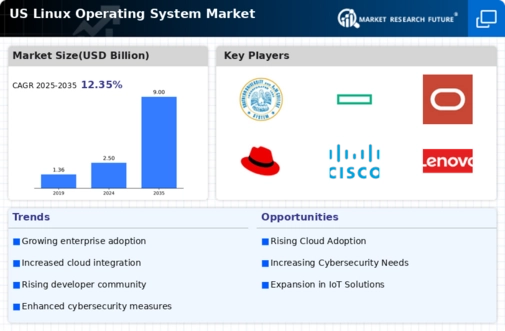The US Linux Operating System Market is characterized by diverse competition among players that cater to varying customer needs across sectors. With Linux being an open-source platform, it allows significant customization and flexibility, making it attractive to both enterprise and individual users. The market is marked by a notable trend towards collaborative development and community involvement, leveraging the contributions from developers to enhance functionalities and security features. Various distributions of Linux add layers of competition, as companies focus on delivering user-friendly interfaces and robust support services to distinguish themselves.
This competitive landscape is further enriched by the demand for cloud-based solutions, leading to an increase in partnerships and integrative solutions enhancing Linux’s adaptability in emerging technologies.SUSE stands out as a formidable player in the US Linux Operating System Market with its commitment to innovation and customer-centric approaches. The company has established a strong presence in sectors demanding enterprise-level solutions, such as finance, healthcare, and telecommunications. SUSE's strengths lie in its robust support networks, extensive training programs, and a strong focus on hybrid cloud environments that resonate well with modern business requirements.
By fostering collaborations and partnerships with key industry players, SUSE has been able to optimize its offerings, streamline migration processes, and empower organizations to modernize their IT infrastructures. Its enterprise-grade offerings come with deep-rooted security features and superior performance, making it a trusted choice for companies looking to leverage Linux solutions.VMware, while primarily known for its virtualization technologies, has made significant strides in the US Linux Operating System Market by integrating Linux capabilities into its core offerings.
The company's key products, such as VMware Cloud and vSphere, leverage Linux environments to deliver enhanced performance and scalability, addressing the growing demands for cloud infrastructure in the region. VMware's strengths in this market are bolstered by its comprehensive portfolio that supports hybrid cloud architectures, automation, and management solutions, making it vital for organizations transitioning to cloud-native strategies. The company is recognized for its strategic mergers and acquisitions, allowing it to integrate advanced technologies and improve its service offerings.
By fostering a robust ecosystem around its products, VMware remains a competitor that blends traditional virtualization solutions with modern Linux capabilities, providing a comprehensive solution for businesses looking to optimize their operations in an increasingly digital world.
























Leave a Comment